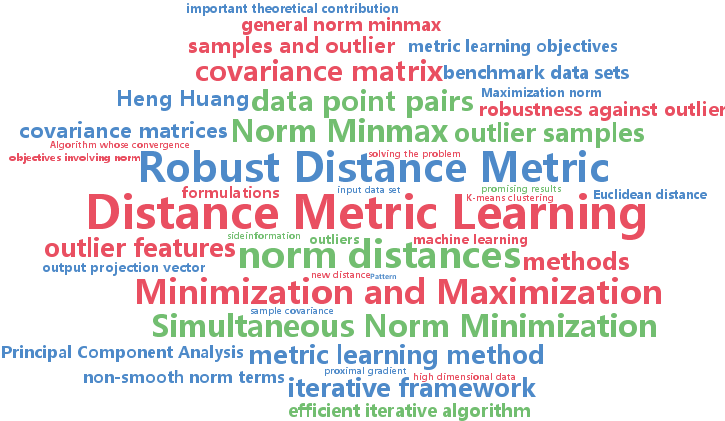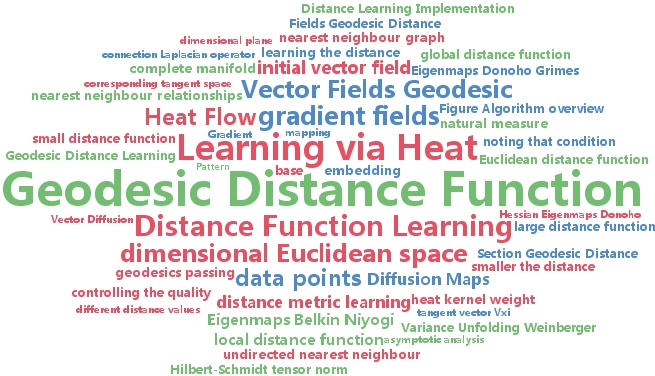distance metric learning
-
Matt Kusner and Stephen Tyree and Kilian Weinberger and Kunal Agrawal
Stochastic Neighbor Compression (pdf)
We present Stochastic Neighborhood Compression (SNC), an algorithm to compress a dataset for the purpose of k-nearest neighbor (kNN) classification. Given training data, SNC learns a much smaller synthetic data set, that minimizes the stochastic 1-nearest neighbor classification error on the training data. This approach has several appealing properties: due to its small size, the compressed set speeds up kNN testing drastically (up to several orders of magnitude, in our experiments); it makes the kNN classifier substantially more robust to label noise; on 4 of 7 data sets it yields lower test error than kNN on the entire training set, even at compression ratios as low as 2%; finally, the SNC compression leads to impressive speed ups over kNN even when kNN and SNC are both used with ball-tree data structures, hashing, and LMNN dimensionality reduction, demonstrating that it is complementary to existing state-of-the-art algorithms to speed up kNN classification and leads to substantial further improvements.
-
Hua Wang and Feiping Nie and Heng Huang
Robust Distance Metric Learning via Simultaneous L1-Norm Minimization and Maximization (pdf)
Traditional distance metric learning with side information usually formulates the objectives using the covariance matrices of the data point pairs in the two constraint sets of must-links and cannot-links. Because the covariance matrix computes the sum of the squared L2-norm distances, it is prone to both outlier samples and outlier features. To develop a robust distance metric learning method, in this paper we propose a new objective for distance metric learning using the L1-norm distances. However, the resulted objective is very challenging to solve, because it simultaneously minimizes and maximizes (minmax) a number of non-smooth L1-norm terms. As an important theoretical contribution of this paper, we systematically derive an efficient iterative algorithm to solve the general L1-norm minmax problem, which is rarely studied in literature. We have performed extensive empirical evaluations, where our new distance metric learning method outperforms related state-of-the-art methods in a variety of experimental settings to cluster both noiseless and noisy data.
-
Binbin Lin and Ji Yang and Xiaofei He and Jieping Ye
Geodesic Distance Function Learning via Heat Flow on Vector Fields (pdf)
Learning a distance function or metric on a given data manifold is of great importance in machine learning and pattern recognition. Many of the previous works first embed the manifold to Euclidean space and then learn the distance function. However, such a scheme might not faithfully preserve the distance function if the original manifold is not Euclidean. In this paper, we propose to learn the distance function directly on the manifold without embedding. We first provide a theoretical characterization of the distance function by its gradient field. Based on our theoretical analysis, we propose to first learn the gradient field of the distance function and then learn the distance function itself. Specifically, we set the gradient field of a local distance function as an initial vector field. Then we transport it to the whole manifold via heat flow on vector fields. Finally, the geodesic distance function can be obtained by requiring its gradient field to be close to the normalized vector field. Experimental results on both synthetic and real data demonstrate the effectiveness of our proposed algorithm.
-
Daryl Lim and Gert Lanckriet
Efficient Learning of Mahalanobis Metrics for Ranking (pdf)
We develop an efficient algorithm to learn a Mahalanobis distance metric by directly optimizing a ranking loss. Our approach focuses on optimizing the top of the induced rankings, which is desirable in tasks such as visualization and nearest-neighbor retrieval. We further develop and justify a simple technique to reduce training time significantly with minimal impact on performance. Our proposed method significantly outperforms alternative methods on several real-world tasks, and can scale to large and high-dimensional data.



